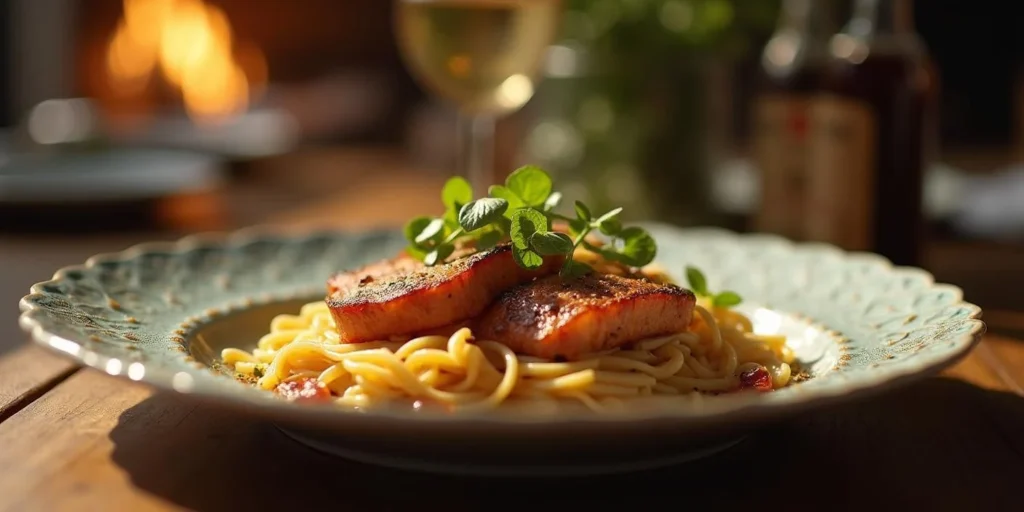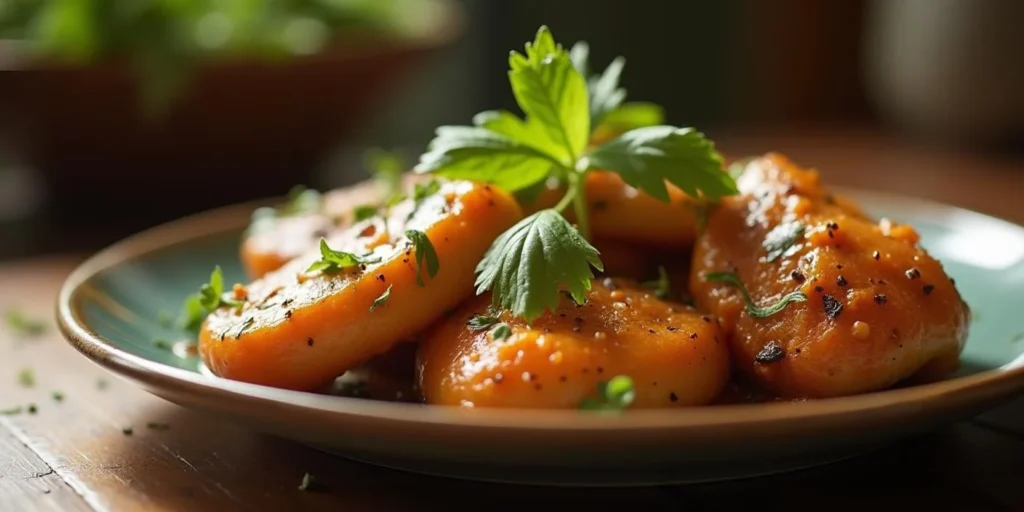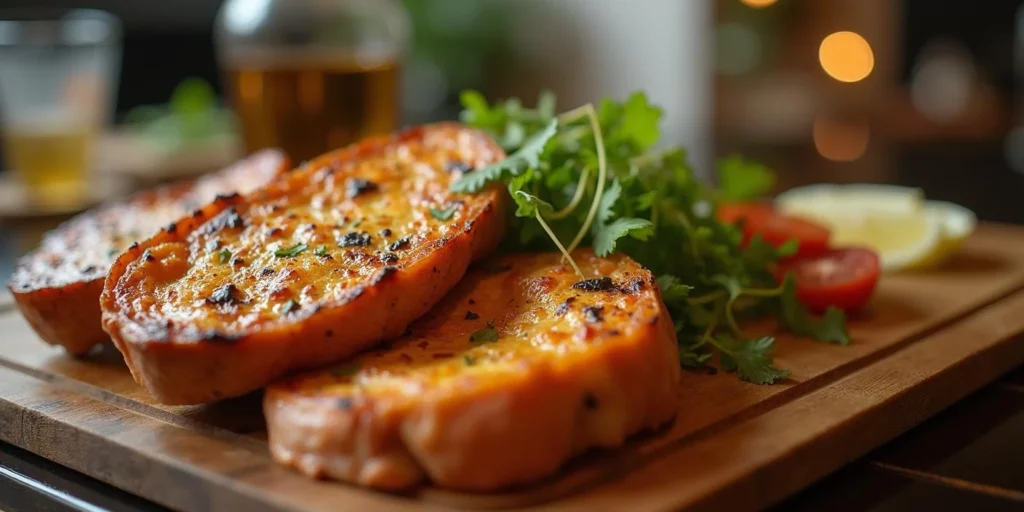Weight Watchers Dinner Recipes offer a perfect way to enjoy delicious meals while maintaining a healthy lifestyle. Designed to align with the Weight Watchers program, these recipes use the Smart Points system to promote balanced eating and weight loss without deprivation.
This article explores the benefits of Weight Watchers Dinner Recipes, provides practical tips, and shares quick, easy meal ideas. Whether you’re looking for budget-friendly options, global flavors, or meals for specific diets, you’ll find plenty of inspiration.
Ready to transform your dinners? Let’s dive into Weight Watchers Dinner Recipes and bring both flavor and health to your table!
Why Weight Watchers Dinner Recipes Work for Healthy Eating

Weight Watchers dinner recipes provide more than just tasty meals—they offer a gateway to better health, effective weight management, and a sustainable eating plan. Let’s take an in-depth look at the many benefits these recipes bring to your lifestyle:
1. Vegetables That Make the Best Weight Watchers Dinners
Weight Watchers dinner recipes emphasize the consumption of wholesome ingredients, such as vegetables, lean proteins, and whole grains. As a result, this focus contributes to several health benefits:
- Improved Heart Health: Recipes low in saturated fats and high in fiber help reduce cholesterol levels, supporting cardiovascular well-being.
- Balanced Blood Sugar: Meals centered on low-glycemic ingredients help maintain steady glucose levels, thereby reducing the risk of type 2 diabetes.
- Enhanced Digestion: The inclusion of fiber-rich foods, like whole grains and vegetables, promotes a healthy digestive system.
2. Weight Loss Benefits
One of the primary goals of the Weight Watchers program is to foster weight loss in a sustainable way. Dinner recipes that fit into this program are particularly effective because they:
- Promote Portion Control: Recipes provide appropriate serving sizes, helping to avoid overeating and unnecessary calorie intake.
- Encourage Smart Choices: By assigning Smart Points to foods, the program nudges you toward nutrient-dense options rather than calorie-dense ones.
- Satisfy Hunger: Balanced meals, rich in fiber and protein, ensure you feel full, making it easier to resist unhealthy snacks after dinner.
3. Nutritional Balance
Weight Watchers recipes are carefully designed to balance macronutrients like carbohydrates, proteins, and fats, while also being rich in essential vitamins and minerals. This thoughtful approach helps to:
- Boost Energy Levels: Complex carbs and lean proteins keep you energized throughout the evening, preventing post-dinner fatigue.
- Support Immune Function: Many recipes include superfoods like leafy greens, citrus fruits, and seeds, which strengthen your immunity.
- Enhance Overall Well-Being: By eating a wide variety of healthy ingredients, you support both your mental and physical health.
In conclusion, Weight Watchers dinner recipes combine the joys of cooking and eating with the assurance that you’re nourishing your body in the best way possible. Next, we’ll explore the key principles that make these recipes unique and effective.
Table of contents
Key Principles of Weight Watchers-Friendly Recipes

Weight Watchers dinner recipes are guided by specific principles designed to ensure healthy, satisfying, and effective meals for weight management. These principles make it easier to stick to your wellness goals without sacrificing taste or convenience. Let’s explore the core elements that define these recipes:
1. Focus on Portion Control
Portion control is at the heart of the Weight Watchers program. Dinner recipes emphasize serving sizes that align with your daily Smart Points allowance, helping you avoid overeating while still feeling satisfied.
- Why It Works: Proper portion sizes prevent overindulgence and keep calorie intake in check.
- Example: Instead of a heaping plate of pasta, Weight Watchers recipes might suggest a single cup of whole-grain pasta paired with plenty of vegetables and lean protein.
2. Importance of Zero Point Foods
Zero Point foods are a cornerstone of Weight Watchers meal planning. These are nutrient-dense ingredients that don’t count towards your Smart Points, allowing for flexibility in creating meals.
- Examples: Most fruits, non-starchy vegetables, beans, eggs, and plain non-fat yogurt.
- Benefits: By incorporating these foods, you can build meals that are both filling and low in points.
- Practical Tip: Start your dinner with a base of Zero Point foods like a big leafy salad or a vegetable-packed soup.
3. Smart Points System
The Smart Points system simplifies healthy eating by assigning a value to foods based on their calories, saturated fat, sugar, and protein content.
- Low-Point Ingredients: Foods high in protein and low in sugar typically have fewer points.
- High-Point Ingredients: Processed and sugary items often carry a higher point value.
- Application: By following this system, you can quickly evaluate which ingredients and recipes fit within your daily points budget.
4. Balance of Macronutrients
Weight Watchers recipes prioritize the balance of proteins, carbohydrates, and fats. This ensures sustained energy and satiety without compromising on taste.
- Lean Proteins: Chicken, turkey, fish, tofu, and legumes are often featured to provide muscle-building nutrients.
- Complex Carbs: Whole grains, sweet potatoes, and quinoa offer slow-burning energy.
- Healthy Fats: Recipes include nuts, seeds, and avocado in moderation to support brain health and hormone balance.
5. Flavor Without Excess Calories
Weight Watchers recipes rely on herbs, spices, and other low-calorie seasonings to boost flavor without adding unnecessary points.
- Popular Choices: Garlic, ginger, cumin, paprika, and fresh herbs like cilantro or basil.
- Reduced Dependence on Salt: Recipes often encourage using lemon juice, vinegar, or pepper to enhance taste instead of sodium-heavy condiments.
By adhering to these principles, Weight Watchers dinner recipes become a practical and enjoyable way to maintain a healthy lifestyle. Next, we’ll dive into the essential ingredients used in these recipes to create nutritious and flavorful meals.
Must-Have Ingredients for Weight Watchers Dinner Recipes

The success of any Weight Watchers dinner recipe lies in the ingredients. By selecting nutrient-dense, low-point foods, you can create meals that are both satisfying and aligned with your goals. Below is a breakdown of key ingredients you’ll frequently encounter in Weight Watchers-friendly recipes.
1. Low-Calorie Vegetables
Vegetables are essential for Weight Watchers dinners, offering volume and nutrition with minimal points.
- Leafy Greens: Spinach, kale, arugula, and Swiss chard are great for salads, stir-fries, or as a base for main courses.
- Non-Starchy Vegetables: Broccoli, zucchini, bell peppers, cauliflower, and asparagus are versatile Zero Point ingredients.
- Flavorful Additions: Mushrooms, onions, and tomatoes can add depth to soups, stews, and casseroles.
- Cooking Tip: Roast or steam vegetables to retain their nutrients while enhancing their natural sweetness.
2. Lean Proteins
Protein is a cornerstone of Weight Watchers recipes, providing satiety and essential amino acids without adding excessive points.
- Poultry: Skinless chicken breast and turkey are staples due to their low-fat content.
- Fish and Seafood: Salmon, cod, shrimp, and tuna offer heart-healthy omega-3 fatty acids.
- Plant-Based Options: Lentils, black beans, chickpeas, and tofu are great for vegetarians.
- Eggs: As a Zero Point food, eggs can be used in omelets, casseroles, or frittatas.
- Cooking Tip: Grill or bake proteins to reduce fat while keeping them tender and flavorful.
3. Whole Grains
Whole grains provide energy and fiber, making them an essential component of Weight Watchers dinners.
- Quinoa: A complete protein that works well in salads, bowls, or as a rice substitute.
- Brown Rice: A fiber-rich alternative to white rice.
- Whole-Grain Pasta: Pair it with vegetable-packed sauces to keep points low.
- Barley and Bulgur: Ideal for soups or as a base for Mediterranean-inspired dishes.
- Portion Control Tip: Stick to the recommended serving size to avoid exceeding your SmartPoints budget.
4. Healthy Fats
Healthy fats add richness to meals while supporting overall health, but moderation is key.
- Avocado: Use as a topping or blend into dressings for creamy textures.
- Nuts and Seeds: Almonds, walnuts, chia seeds, and flaxseeds can be sprinkled on salads or used in granolas.
- Oils: Olive oil and avocado oil are preferred for their heart-health benefits. Use sparingly to minimize points.
- Portion Tip: Measure oils and fats carefully, as they can add up quickly in points.
5. Flavor Boosters
Instead of relying on high-calorie sauces, Weight Watchers recipes lean on natural flavor enhancers.
- Herbs and Spices: Basil, oregano, cumin, paprika, turmeric, and cilantro elevate dishes without adding calories.
- Acidic Ingredients: Lemon juice, balsamic vinegar, and apple cider vinegar bring brightness to recipes.
- Low-Sodium Broth: A great base for soups, stews, and sauces.
- Cooking Tip: Experiment with spice blends like taco seasoning or curry powder to add global flavors to your meals.
6. Dairy and Alternatives
While full-fat dairy can be point-heavy, there are plenty of lighter options:
- Low-Fat Cheese: Use shredded part-skim mozzarella or grated Parmesan for controlled portions.
- Greek Yogurt: Plain, non-fat Greek yogurt is Zero Point and works as a creamy base for dips, dressings, or marinades.
- Milk Alternatives: Unsweetened almond or oat milk is often lower in points than traditional dairy.
- Cooking Tip: Use dairy alternatives to reduce points while maintaining flavor and texture.
Weight Watchers dinner recipes thrive on the use of these healthy, delicious ingredients. By focusing on fresh, whole foods and being mindful of portions, you can enjoy meals that align with your goals without sacrificing taste.
Cooking Methods for Weight Watchers Dinner Recipes
The way you cook your meals can significantly impact their healthfulness and SmartPoints value. Therefore, choosing the right cooking methods is essential for achieving your health goals. Weight Watchers-friendly cooking methods, in particular, focus on maximizing flavor while simultaneously minimizing the use of fats and high-calorie ingredients. As a result, you can enjoy meals that are both delicious and aligned with your wellness plan. Below, you’ll find the top techniques for preparing Weight Watchers dinner recipes effectively.
1. Grilling
Grilling is a fantastic method for cooking lean proteins and vegetables with minimal added fat. Not only is it simple, but it also adds a smoky, rich flavor to your meals.
Advantages:
- Imparts a smoky, rich flavor without the need for heavy sauces.
- Excess fat drips off, making meals naturally lower in calories.
Best Foods for Grilling:
- Chicken breast, turkey burgers, and firm fish like salmon or swordfish.
- Vegetables such as zucchini, eggplant, bell peppers, and asparagus.
Pro Tip: Marinate proteins and vegetables in a mixture of olive oil, lemon juice, and spices to enhance flavor without adding points.
2. Roasting
Roasting is perfect for caramelizing the natural sugars in vegetables and creating crispy textures with little to no oil. This technique is particularly great for meal prep or hearty sides.
Advantages:
- Retains nutrients while creating deep, savory flavors.
- Allows you to cook large batches at once, which is ideal for meal prep.
Best Foods for Roasting:
- Root vegetables like carrots, sweet potatoes, and parsnips.
- Brussels sprouts, cauliflower, and squash.
Pro Tip: Toss veggies with a light spray of cooking oil and sprinkle with herbs for a low-point side dish.
3. Steaming
Steaming preserves the nutrients and vibrant colors of vegetables without requiring oil or butter. It’s an excellent choice for those looking for a quick, healthy cooking method.
Advantages:
- A quick and easy method for preparing Zero Point vegetables.
- Perfect for those following a low-sodium diet since it doesn’t require seasoning during cooking.
Best Foods for Steaming:
- Leafy greens like spinach, kale, and bok choy.
- Broccoli, green beans, and snap peas.
Pro Tip: Add a squeeze of lemon juice or a drizzle of balsamic vinegar after steaming for extra flavor.
4. Sautéing
Sautéing uses minimal oil to cook ingredients quickly, making it ideal for stir-fries and one-pan meals. This method is perfect for layering flavors while keeping dishes light.
Advantages:
- Retains the crunch and color of vegetables.
- Allows for layering flavors with garlic, ginger, and spices.
Best Foods for Sautéing:
- Mixed vegetables like mushrooms, onions, and bell peppers.
- Protein options such as shrimp, tofu, or lean cuts of chicken.
Pro Tip: Use a non-stick pan or a light spray of cooking oil to reduce points.
5. Baking
Baking is a versatile method that works for proteins, casseroles, and even low-point desserts. It’s particularly convenient for meal prep or feeding a family.
Advantages:
- Requires minimal active time, as the oven does most of the work.
- Ideal for preparing larger portions to serve multiple people.
Best Foods for Baking:
- Lean proteins like chicken, turkey, or fish fillets.
- Dishes like vegetable lasagna, stuffed peppers, or turkey meatballs.
Pro Tip: Use parchment paper or silicone baking mats to reduce the need for oil or butter.
6. Air Frying
Air frying is an excellent method for achieving crispy textures without the added calories of deep frying. For those who crave crunch, this is a game-changer.
Advantages:
- Requires little to no oil while delivering crunch and flavor.
- Great for preparing healthier versions of traditionally fried foods.
Best Foods for Air Frying:
- Sweet potato fries, chicken tenders, or zucchini chips.
- Frozen items like fish fillets or pre-cut vegetables.
Pro Tip: Pre-season your ingredients with herbs and spices to make them more flavorful.
7. Using Slow Cookers or Instant Pots
These tools are ideal for creating hearty, one-pot meals with minimal effort. They’re especially helpful for busy nights when you need dinner ready without constant monitoring.
Advantages:
- Enhances flavors by cooking ingredients slowly over time.
- Perfect for stews, soups, and chili with low-point ingredients.
Best Foods for Slow Cooking:
- Lentil or vegetable soups, turkey chili, and shredded chicken.
- Zero Point foods like beans, tomatoes, and broth-based dishes.
Pro Tip: Use low-sodium broths and skip cream-based additives to keep points low.
8. Poaching
Poaching involves gently simmering proteins or vegetables in water or broth. This gentle cooking method is particularly ideal for keeping foods tender and flavorful without adding fats.
Advantages:
- First and foremost, it keeps proteins tender without added fats.
- Additionally, it maintains the natural flavors of ingredients, allowing them to shine.
Best Foods for Poaching:
- Eggs, chicken breast, and fish like cod or haddock.
- Fruits like pears for dessert options.
Pro Tip: To enhance the flavor of your dishes, add aromatics like bay leaves, garlic, or peppercorns to the poaching liquid.
Try Chicken and Yellow Rice for a flavorful one-pot meal with tender chicken, or enjoy Onion Soup Mix Chicken and Rice, an easy, savory dish cooked together for rich flavor. For a restaurant-style favorite, Longhorn Parmesan Crusted Chicken delivers juicy chicken with a crispy parmesan crust.
Top 5 Quick Weight Watchers Dinner Recipes

Here are five easy and delicious Weight Watchers dinner recipes that are quick to prepare and align perfectly with the program. Not only are these recipes low in SmartPoints, but they are also nutrient-dense and satisfying enough to become household favorites.
1. Grilled Lemon Herb Chicken
Smart Points: 3 per serving
Ingredients:
- 4 skinless, boneless chicken breasts
- Juice of 2 lemons
- 2 tbsp olive oil
- 2 cloves garlic, minced
- 1 tsp dried oregano
- 1 tsp dried thyme
- Salt and pepper to taste
Instructions:
- Combine lemon juice, olive oil, garlic, oregano, thyme, salt, and pepper in a bowl.
- Add the chicken breasts to the marinade and let sit for 20 minutes.
- Preheat the grill to medium heat and cook the chicken for 6-8 minutes per side until fully cooked.
- Serve with a side of steamed vegetables or a simple green salad.
Why It Works: Packed with protein and flavor, this dish keeps points low while satisfying hunger.
2. Zucchini Noodles with Turkey Marinara
Smart Points: 4 per serving
Ingredients:
- 4 medium zucchinis, spiralized
- 1 lb ground turkey (93% lean)
- 2 cups crushed tomatoes
- 1 small onion, diced
- 2 cloves garlic, minced
- 1 tsp Italian seasoning
- 1 tbsp olive oil
- Salt and pepper to taste
Instructions:
Here’s a revised version with more transition words to improve the flow and readability of the instructions:
- Heat olive oil in a pan over medium heat.
- Next, sauté the onion and garlic until they become fragrant.
- Then, add the ground turkey and cook until it is browned.
- Once the turkey is ready, stir in the crushed tomatoes, Italian seasoning, salt, and pepper. Allow the mixture to simmer for about 15 minutes, letting the flavors meld together.
- Meanwhile, in a separate pan, lightly sauté the zucchini noodles for 2-3 minutes, just until they soften slightly.
Finally, top the zucchini noodles with the turkey marinara sauce and serve.
Why It Works: Swapping traditional pasta for zucchini noodles cuts down on points while still offering the comforting appeal of a classic dish.
3. Spiced Lentil Stew
Smart Points: 1 per serving
Ingredients:
- 1 cup dried lentils, rinsed
- 1 onion, diced
- 2 carrots, chopped
- 2 stalks celery, chopped
- 3 cups vegetable broth
- 1 can diced tomatoes (14 oz)
- 1 tsp cumin
- 1 tsp paprika
- 1 tsp turmeric
- 1 tbsp olive oil
Instructions:
- Heat olive oil in a large pot over medium heat. Next, sauté the onion, carrots, and celery until they are softened.
- Then, add the cumin, paprika, and turmeric. Stir to coat the vegetables evenly with the spices.
- After that, stir in the lentils, broth, and diced tomatoes. Bring the mixture to a boil, then reduce the heat and let it simmer for 25-30 minutes until the lentils are tender.
- Finally, serve with a sprinkle of fresh parsley on top for added freshness.
Why It Works: This hearty stew is filling and loaded with Zero Point foods, which makes it a fantastic option for a low-point dinner.
4. Salmon with Quinoa and Vegetables
Smart Points: 6 per serving
Ingredients:
- 4 salmon fillets (4 oz each)
- 1 cup quinoa
- 2 cups broccoli florets
- 2 tbsp olive oil
- Juice of 1 lemon
- 1 tsp garlic powder
- Salt and pepper to taste
Instructions:
- Preheat the oven to 400°F (200°C). Place the salmon fillets on a baking sheet lined with parchment paper.
- Drizzle salmon with 1 tbsp olive oil, lemon juice, garlic powder, salt, and pepper. Bake for 12-15 minutes.
- While the salmon cooks, prepare the quinoa according to package instructions.
- Steam the broccoli florets until tender.
- Plate the salmon with quinoa and broccoli, and serve.
Why It Works: This balanced meal provides healthy fats, protein, and fiber to keep you full and on track.
5. Veggie Stir-Fry with Tofu
Smart Points: 2 per serving
Ingredients:
- 1 block firm tofu, cubed
- 2 cups mixed vegetables (e.g., bell peppers, snap peas, carrots, mushrooms)
- 2 tbsp low-sodium soy sauce
- 1 tsp sesame oil
- 1 clove garlic, minced
- 1 tsp grated ginger
- 1 tsp cornstarch mixed with 2 tbsp water
Instructions:
- Heat sesame oil in a wok or large skillet over medium heat. Add tofu cubes and cook until golden on all sides. Remove and set aside.
- Add garlic and ginger to the pan, followed by the mixed vegetables. Stir-fry for 4-5 minutes.
- Stir in the soy sauce and cornstarch mixture, cooking for another 2 minutes until the sauce thickens.
- Return the tofu to the pan, mix well, and serve hot.
Why It Works: This low-point dish is packed with protein and vegetables, making it a quick, nutritious dinner option.
These recipes prove that healthy eating on the Weight Watchers program can be flavorful, varied, and satisfying. Whether you prefer hearty stews, fresh seafood, or plant-based dishes, there’s something here to inspire your next dinner.
Conclusion of Weight Watchers Dinner Recipes
Weight Watchers dinner recipes offer a perfect mix of health, flavor, and simplicity. With portion control, Smart Points, and Zero Point foods, you can enjoy satisfying meals without guilt. From Grilled Lemon Herb Chicken to Spiced Lentil Stew and Zucchini Noodles with Turkey Marinara, there are endless Weight Watchers dinner ideas to explore. These easy Weight Watchers dinner recipes use healthy cooking methods like grilling and air frying to keep points low while maximizing taste. Eating well has never been this delicious!

